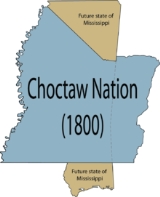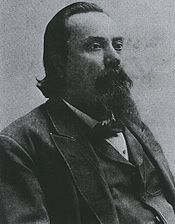
Choctaw Trail of Tears
Encyclopedia

Choctaw
The Choctaw are a Native American people originally from the Southeastern United States...
Nation from their country referred to now as the Deep South
Deep South
The Deep South is a descriptive category of the cultural and geographic subregions in the American South. Historically, it is differentiated from the "Upper South" as being the states which were most dependent on plantation type agriculture during the pre-Civil War period...
(Alabama
Alabama
Alabama is a state located in the southeastern region of the United States. It is bordered by Tennessee to the north, Georgia to the east, Florida and the Gulf of Mexico to the south, and Mississippi to the west. Alabama ranks 30th in total land area and ranks second in the size of its inland...
, Arkansas
Arkansas
Arkansas is a state located in the southern region of the United States. Its name is an Algonquian name of the Quapaw Indians. Arkansas shares borders with six states , and its eastern border is largely defined by the Mississippi River...
, Mississippi
Mississippi
Mississippi is a U.S. state located in the Southern United States. Jackson is the state capital and largest city. The name of the state derives from the Mississippi River, which flows along its western boundary, whose name comes from the Ojibwe word misi-ziibi...
, and Louisiana
Louisiana
Louisiana is a state located in the southern region of the United States of America. Its capital is Baton Rouge and largest city is New Orleans. Louisiana is the only state in the U.S. with political subdivisions termed parishes, which are local governments equivalent to counties...
) to lands west of the Mississippi River
Mississippi River
The Mississippi River is the largest river system in North America. Flowing entirely in the United States, this river rises in western Minnesota and meanders slowly southwards for to the Mississippi River Delta at the Gulf of Mexico. With its many tributaries, the Mississippi's watershed drains...
in Indian Territory
Indian Territory
The Indian Territory, also known as the Indian Territories and the Indian Country, was land set aside within the United States for the settlement of American Indians...
in the 1830s. A Choctaw minko (chief) was quoted by the Arkansas Gazette that the removal was a "trail of tears and death." After removal the Choctaws became three distinct groups, the Choctaw Nation of Oklahoma
Choctaw Nation of Oklahoma
The Choctaw Nation of Oklahoma is a semi-autonomous Native American homeland comprising twelve tribal districts. The Choctaw Nation maintains a special relationship with both the United States and Oklahoma governments...
, Jena Band of Choctaw Indians
Jena Band of Choctaw Indians
The Jena Band of Choctaw Indians are one of three federally-recognized Choctaw groups in the United States. They are based in La Salle and Catahoula Parishes in the U.S. state of Louisiana. The Jena Band received federal recognition in 1995. Tribal membership totals 241.-Government:The tribe is...
, and the Mississippi Band of Choctaw Indians
Mississippi Band of Choctaw Indians
The Mississippi Band of Choctaw Indians is one of three federally recognized tribes of Choctaw Indians. On April 20, 1945, the tribe organized under the Indian Reorganization Act of 1934. Also in 1945 the Choctaw Indian Reservation was created in Neshoba and surrounding counties...
.
Overview

Andrew Jackson
Andrew Jackson was the seventh President of the United States . Based in frontier Tennessee, Jackson was a politician and army general who defeated the Creek Indians at the Battle of Horseshoe Bend , and the British at the Battle of New Orleans...
was anxious to make it a model of removal. George W. Harkins
George W. Harkins
George W. Harkins was an attorney and prominent chief of the Choctaw tribe during the Indian removals. Elected as principal chief after the national council deposed his maternal uncle, Greenwood LeFlore, in 1834 Harkins was elected judge of the Red River District in Indian Territory...
wrote a letter to the American people before the removals began.
The first wave of removal suffered the most. The second and third wave "sowed their fields promptly and experienced fewer hardships than the Indians of most of the other expatriated tribes." Removal continued throughout the 19th century. In 1846 1,000 Choctaw removed, and by 1930 1,665 remained in Mississippi.
Treaties
The Choctaw and the United States agreed to nine treaties between 1786 and 1830. The Treaty of Dancing Rabbit Creek was the last to be signed agreeing to the final removal of the Choctaw Nation. Choctaw land was systematically obtained through treaties, legislation, and threats of warfare. Treaties were made with Great Britain, France, and Spain. Nine treaties were signed with the United States. Some treaties, like the Treaty of San Lorenzo, indirectly affected the Choctaws.The Choctaws considered European laws and diplomacy foreign and puzzling. The most confusing aspect of treaty making was writing which was impressive for a people who have not developed a written system. Choctaw history, as with many Native Americans, was passed orally from generation to generation. Europeans needed treaties to satisfy their cultural laws and ease their consciences. During treaty negotiations the three main Choctaw tribal areas (Upper Towns, Six town, and Lower Towns) had a "Miko" (chief) to represent them. Spain had the earliest claims to Choctaw country which was followed by French claims starting in the late 17th century. The United States, following the Treaty of San Lorenzo, laid claim to Choctaw country starting in 1795.
| Treaty | Year | Ceded Land |
| Hopewell Treaty of Hopewell The Treaty of Hopewell is any of three different treaties signed at Hopewell Plantation. The plantation was owned by Andrew Pickens, and was located on the Seneca River in northwestern South Carolina. The treaties were signed between the Confederation Congress of the United States of America and... |
1786 | n/a |
| Fort Adams Treaty of Fort Adams The Treaty of Fort Adams was signed on December 17, 1801 between the Choctaw and the United States Government. The treaty ceded about of Choctaw land... |
1801 | 2641920 acres (10,691.5 km²) |
| Fort Confederation Treaty of Fort Confederation The Treaty of Fort Confederation was signed on October 17, 1802 between the Choctaw and the United States Government. The treaty ceded about of Choctaw land, including the site of Fort Tombecbe, also known as Fort Confederation.... |
1802 | 10000 acres (40.5 km²) |
| Hoe Buckintoopa Treaty of Hoe Buckintoopa The Treaty of Hoe Buckintoopa was signed on August 31, 1803 between the Choctaw and the United States Government. The treaty ceded about of Choctaw land.-Terms:The preamble begins with,1... |
1803 | 853760 acres (3,455 km²) |
| Mount Dexter Treaty of Mount Dexter The Treaty of Mount Dexter was signed between the United States and the Choctaws. The treaty was signed November 16, 1805. The area ceded was from the Natchez District to the Tombigbee Alabama River watershed, mostly in present-day Mississippi.-Terms:... |
1805 | 4142720 acres (16,765 km²) |
| Fort St. Stephens Treaty of Fort St. Stephens The Treaty of Fort St. Stephens or Treaty of Choctaw Trading House was signed between the United States and the Choctaws. The treaty was signed at the Choctaw trading house on October 24, 1816. It ceded of Choctaw land east of the Tombigbee River. The land was exchanged for 6,000 US dollars... |
1816 | 10000 acres (40.5 km²) |
| Doak's Stand Treaty of Doak's Stand The Treaty of Doak's Stand was signed on October 18, 1820 between the United States and the Choctaw Indian tribe. Based on the terms of the accord, the Choctaw agreed to give up approximately one-half of their remaining Choctaw homeland... |
1820 | 5169788 acres (20,921.4 km²) |
| Washington City Treaty of Washington City The Treaty of Washington City was a treaty signed on January 20, 1825 between the Choctaw and the United States Government.-Overview:... |
1825 | 2000000 acres (8,093.7 km²) |
| Dancing Rabbit Creek Treaty of Dancing Rabbit Creek The Treaty of Dancing Rabbit Creek was a treaty signed on September 27, 1830 between the Choctaw and the United States Government. This was the first removal treaty carried into effect under the Indian Removal Act... |
1830 | 10523130 acres (42,585.6 km²) |
Aftermath

Indian Territory
The Indian Territory, also known as the Indian Territories and the Indian Country, was land set aside within the United States for the settlement of American Indians...
and then later Oklahoma
Oklahoma
Oklahoma is a state located in the South Central region of the United States of America. With an estimated 3,751,351 residents as of the 2010 census and a land area of 68,667 square miles , Oklahoma is the 28th most populous and 20th-largest state...
. About 2,500 died along the trail of tears. Approximately 5,000–6,000 Choctaws remained in Mississippi in 1831 after the initial removal efforts. For the next ten years they were objects of increasing legal conflict, harassment, and intimidation. The Choctaws describe their situation in 1849, "we have had our habitations torn down and burned, our fences destroyed, cattle turned into our fields and we ourselves have been scourged, manacled, fettered and otherwise personally abused, until by such treatment some of our best men have died." Racism
Racism
Racism is the belief that inherent different traits in human racial groups justify discrimination. In the modern English language, the term "racism" is used predominantly as a pejorative epithet. It is applied especially to the practice or advocacy of racial discrimination of a pernicious nature...
was rampant. Joseph B. Cobb, who moved to Mississippi from Georgia, described Choctaws as having "no nobility or virtue at all, and in some respect he found blacks, especially native Africans, more interesting and admirable, the red man's superior in every way. The Choctaw and Chickasaw, the tribes he knew best, were beneath contempt, that is, even worse than black slaves." The removals continued well into the early 20th century. In 1903, three hundred Mississippi Choctaws were persuaded to move to the Nation in Oklahoma.
See also
- Trail of TearsTrail of TearsThe Trail of Tears is a name given to the forced relocation and movement of Native American nations from southeastern parts of the United States following the Indian Removal Act of 1830...
- ChoctawChoctawThe Choctaw are a Native American people originally from the Southeastern United States...
- List of Choctaw Treaties
- Treaty of Dancing Rabbit CreekTreaty of Dancing Rabbit CreekThe Treaty of Dancing Rabbit Creek was a treaty signed on September 27, 1830 between the Choctaw and the United States Government. This was the first removal treaty carried into effect under the Indian Removal Act...

